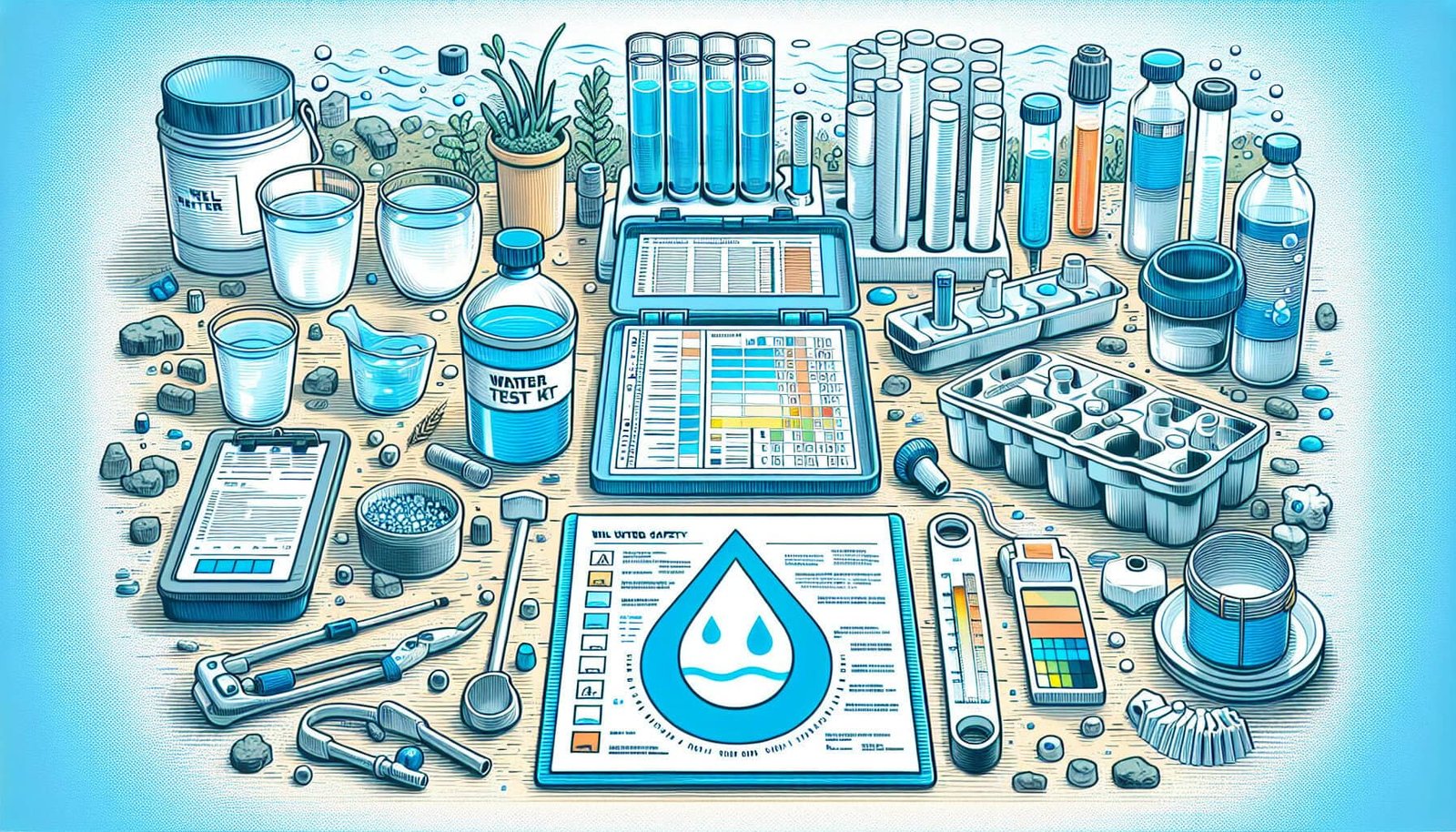If you live in an area where the use of well water is expanding, you may have started to wonder about the safety of this water source. With the growing popularity of well water systems, it is important to understand the potential safety concerns that may arise. In this article, we will explore some practical steps you can take to address these concerns and ensure the safety of your well water. We’ll discuss common issues that can occur and provide actionable advice to help you maintain the quality of your well water, ultimately giving you peace of mind. So, let’s dive in and learn how you can address safety concerns related to well water in areas with well water system expansion.
Ensuring Water Quality
Testing for Contaminants
When it comes to ensuring the safety of well water, testing for contaminants is of utmost importance. Regular water testing allows you to identify any potential pollutants or harmful substances that may have infiltrated your well water. You can conduct tests for common contaminants such as bacteria, viruses, heavy metals, nitrates, and pesticides. These tests can be carried out by certified laboratories or by using at-home water testing kits. By regularly testing your well water, you can take appropriate measures to address any contamination issues promptly.
Addressing Common Contaminants
There are several common contaminants that can significantly impact the quality of your well water. One of the most prevalent contaminants is bacteria, such as E. coli, which can originate from various sources, including sewage leaks and animal waste. In such cases, it is crucial to disinfect the well and take measures to prevent further bacterial contamination. Additionally, heavy metals like lead and arsenic can seep into well water through natural deposits or industrial run-off. Utilizing treatment methods like activated carbon filters, reverse osmosis, or ion exchange can effectively remove these contaminants and improve the quality of your well water.
Implementing Treatment Systems
Implementing treatment systems is a proactive approach to ensuring the quality of well water. While wells can provide a readily available water source, they are not immune to contamination risks. Treatment systems, such as whole-house water filtration systems or point-of-use filters, can act as additional layers of protection against contaminants. These systems can target specific pollutants, ensuring that you and your family have access to clean, safe drinking water. By considering the specific needs and potential contaminants in your area, you can select the most suitable treatment system for your well water.

Maintaining Well Infrastructure
Regular Inspections and Maintenance
Regular inspections and maintenance are essential in maintaining the functionality and longevity of your well infrastructure. Conducting routine inspections allows you to identify any visible issues such as cracks, leaks, or damaged components. Additionally, checking the wellhead, casing, and pump for signs of wear and tear is crucial to prevent potential system failures. Cleaning and disinfecting the well periodically can eliminate any accumulated sediment or biofilm that may impact water quality. By adhering to a well maintenance schedule, you can address minor issues before they become major problems and ensure the consistent delivery of clean, safe well water.
Addressing Potential Issues
Even with regular maintenance, well systems can encounter potential issues that need to be promptly addressed. One common issue is the presence of a malfunctioning or inefficient pump. A malfunctioning pump can result in reduced water pressure or inadequate water supply, impacting your daily water usage. It is crucial to have a professional well contractor inspect and repair the pump if necessary. Another potential issue is the intrusion of surface water, which can occur due to improper well construction or sealing. This can lead to contamination and compromise the quality of your well water. In such cases, it is important to address the issue immediately by repairing or modifying the well’s construction.
Upgrading Well Components
Upgrading well components can significantly enhance the efficiency and safety of your well water system. Technology advancements have introduced various innovative components that can improve water quality and system performance. For example, installing a submersible pump can increase the efficiency of water extraction, reducing energy consumption and costs. Additionally, upgrading the well casing with corrosion-resistant materials can prolong its lifespan and prevent potential contamination risks. Regularly assessing the condition of your well components and consulting with a professional can help you determine if any upgrades or replacements are necessary to maintain optimal well infrastructure.

Educating Well Owners
Promoting Awareness of Contaminants
Educating well owners on the potential contaminants that can impact their well water is crucial in maintaining water safety. Many individuals may not be aware of the specific risks associated with their well water source. By raising awareness about common contaminants, such as bacteria, heavy metals, pesticides, and nitrate, well owners can take proactive steps to mitigate these risks. Public campaigns, educational materials, and online resources can be utilized to disseminate information and promote awareness of the importance of regular water testing and treatment.
Providing Resources for Water Testing
To encourage well owners to prioritize water testing, it is essential to provide them with convenient and accessible resources. Local health departments, environmental organizations, or water utilities can collaborate to offer discounted or subsidized water testing kits. Additionally, online platforms can be utilized to provide guidance on how to collect water samples properly and where to send them for testing. By making these resources readily available, well owners are more likely to take proactive measures in monitoring and addressing any potential contaminants in their well water.
Offering Training on Well Maintenance
Providing training on well maintenance can empower well owners to take an active role in ensuring the longevity and safety of their well systems. Workshops, seminars, or online tutorials can cover various topics, including regular inspections, disinfection techniques, and well infrastructure maintenance. Well owners can learn about the potential issues that may arise with their well system and gain the necessary knowledge and skills to address them. By offering such training, well owners can feel more confident and capable of maintaining their wells and safeguarding their water supply.

Regulatory Measures
Implementing Water Quality Standards
Implementing water quality standards is crucial to ensure the safety and consistency of well water across different regions. These standards can establish allowable limits for various contaminants, ensuring that the well water meets the necessary health and safety requirements. Health departments or regulatory agencies can collaborate with experts in the field to establish and update these standards regularly. By implementing and adhering to these standards, well owners can have confidence in the quality of their water supply, and appropriate measures can be taken if any contaminants exceed the acceptable limits.
Enforcing Well Construction Guidelines
Enforcing well construction guidelines is a pivotal aspect of maintaining the integrity of wells and preventing potential contamination risks. These guidelines outline the proper construction techniques and materials to be used during the initial well installation. Ensuring that well contractors follow these guidelines can significantly reduce the chances of surface water infiltration, bacterial contamination, or other well-related issues. Regular inspections and strict enforcement of these guidelines can contribute to the overall safety and longevity of well infrastructure.
Monitoring and Reporting
Monitoring and reporting mechanisms play a vital role in tracking the quality of well water and identifying potential issues or emerging contaminants. Collaborating with local health departments or environmental agencies can establish a comprehensive monitoring system to regularly assess and analyze well water samples. The results of these analyses can be reported to well owners, allowing them to take appropriate measures if any contaminants are detected. Furthermore, this data can contribute to research efforts, policy development, and the identification of trends or emerging issues in well water quality.

Wastewater Management
Addressing Disposal and Treatment
Effective wastewater management is crucial in maintaining the overall well-being of communities and preventing contamination of well water sources. Proper disposal and treatment methods for wastewater, including residential sewage, agricultural runoff, or industrial effluents, need to be implemented. Utilizing septic systems, wastewater treatment plants, or designated land application sites can ensure that contaminants are adequately treated or disposed of before they can infiltrate the groundwater and contaminate well water sources. Regular maintenance and monitoring of these systems are essential to prevent potential failures or breaches.
Promoting Proper Septic System Use
Promoting proper septic system use is essential to prevent the release of harmful contaminants into the environment and ultimately, well water sources. Educating individuals on the importance of regular septic system maintenance, such as pumping, inspecting for leaks, and preventing the disposal of hazardous substances down drains, can significantly reduce the risk of contamination. Well owners should be encouraged to regularly assess their septic systems and seek professional assistance if required. By promoting responsible septic system use, the potential contamination of well water can be minimized, ensuring the safety of the water supply.
Ensuring Adequate Setbacks
Establishing and enforcing adequate setbacks for various activities, such as agriculture, construction, or waste disposal, is crucial to protect well water sources. Setbacks refer to the minimum distance required between potential contamination sources and wells. These setbacks help ensure that any runoff, infiltration, or accidental spills do not reach the wells and impact the quality of the water supply. By adhering to setback regulations and guidelines, communities can take proactive measures to protect their wells and prevent contamination risks.

Community Engagement
Establishing Communication Channels
Establishing effective communication channels is vital in fostering community engagement and ensuring the dissemination of important information regarding well water. Utilizing various communication platforms, such as newsletters, community websites, or social media groups, can provide well owners with regular updates, educational resources, and opportunities for discussion. These channels also allow well owners to communicate their concerns, share experiences, and seek guidance from experts or fellow community members. By fostering open and transparent communication, well owners can feel more engaged and empowered in safeguarding their well water.
Encouraging Well Water Associations
Encouraging the formation of well water associations or community-based organizations can foster collective efforts in addressing water quality concerns. Well owners can come together to exchange knowledge and experiences, organize outreach programs, or collaborate on well maintenance projects. These associations can serve as a platform for sharing resources, discussing challenges, and advocating for well water quality issues at the local and regional levels. By harnessing community unity and teamwork, well owners can collectively work towards ensuring the safety and sustainability of their well water sources.
Organizing Workshops and Public Meetings
Organizing workshops and public meetings can provide valuable opportunities for well owners to gather information, engage with experts, and share concerns about well water quality. These events can be organized by health departments, environmental organizations, or local authorities and can cover various topics related to water testing, treatment options, well maintenance, and emerging issues. By facilitating these gatherings, well owners can access firsthand knowledge, build connections with professionals, and actively participate in discussions that are vital to safeguarding their water supply.

